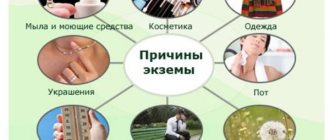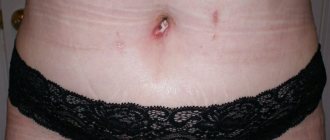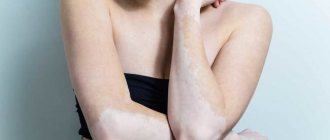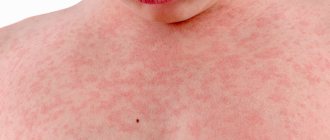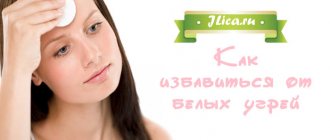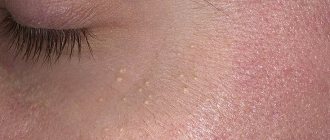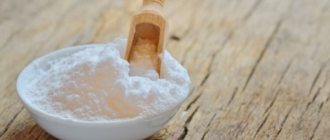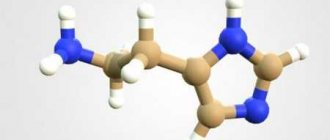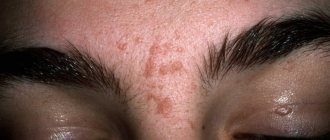General information
Cuperosis (syn. spider veins, telangiectasia ) is a pathology of small blood vessels of the choroid plexus (capillaries, arterioles and venules) located within the subpapillary layer of the dermis, manifested by their persistent expansion and increased fragility.
This pathology (capillaropathy) can occur on any part of the surface of the body: on the legs, on the torso, on the face and other areas. Visually manifests itself in the form of a specific pattern (capillary network), formed by clusters of dilated capillaries. The formation of spider veins in itself does not pose a threat to health and life, but their formation is perceived extremely negatively and affects the quality of life, since many people perceive telangiectasia as a manifestation of vascular disease. Couperosis on the face is of particular importance, which is due to the formation of a cosmetic defect and severe psychological discomfort, especially among females. On the face, they mainly focus on the nose (the sides of the nose) and cheeks. Below are photos of rosacea on the face.
A few words about terminology. It should be noted that the term “rosacea” is used mainly in cosmetology, while in dermatology it is practically not used. In medical practice, its analogue is the term “telangiectasia,” which was specifically introduced to describe a superficial skin vessel visible to the human eye back in 1807.
About 80-90% of adults face the problem of telangiectasia, while their prevalence among women reaches 80%, while among men it is about 20%. Moreover, their frequency of occurrence correlates with age. Thus, in young women under 30 years of age, telangiectasia is detected only in 8% of cases, in women 30-50 years old - in 41%, and in women 70 years of age - in almost 72%. While for males these figures are 1.23 and 42%, respectively. More often, such disorders are typical for people with fair skin.
The diameter of capillary telangiectasia does not exceed 0.2 mm, which vary significantly in shape, location, color, and size. They can occur as single or multiple occurrences. The color and size of telangiectasia is determined primarily by their genesis. telangiectasias that do not protrude above the surface of the skin develop from arterioles and capillaries, while blue ones, often slightly protruding above the surface of the skin, are formed from venules and are wider. Often there is a transformation in the appearance of telangiectasia, that is, from thin and red they transform into wider blue ones, which is due to the “reflux” of blood from the venules under conditions of often increasing hydrostatic pressure.
Telangiectasias occur predominantly on the skin and much less frequently on the mucous membranes of the gastrointestinal tract, nasal cavity, mouth, and genitourinary/respiratory systems. In addition to the skin of the face, telangiectasias are often localized along the posterior outer surface of the thighs, in the popliteal area, in the area of the ankle joints, and also on the feet.
They can occur both as an independent phenomenon and in combination with other anomalies of the vascular bed (angiomas, shunts, arteriovenous aneurysms). Telangiectasia can be either a manifestation of a congenital syndrome or a manifestation of one of the symptoms of the disease. In this case, vascular changes can be of acquired or congenital origin.
Thus, telangiectasias, in addition to aesthetic ones, also cause physical suffering, which makes it possible to consider such changes in intradermal veins as a pathological process, and people suffering from rosacea require special treatment.
Facial massage is an effective way to get rid of
Many experts recommend massage during the treatment of rosacea. As a rule, the most effective is the Spanish modeling massage for the neck and face. During the session, the specialist qualitatively works the muscle area in the area of unwanted “patterns”. This procedure allows you to tone the vascular network and gradually eliminate the vascular pattern.
Some cosmetologists and dermatologists advise their patients to undergo a course of plastic massage. Typically, the specialist does not use creams or oils during the procedure. However, a strong and rhythmic effect is applied to the skin, which tones the blood vessels and restores elasticity to the skin.
Pathogenesis
In the pathogenesis of the development of telangiectasia, the leading role belongs to the glycoprotein endoglin , which is involved in the processes of proliferation, differentiation and preservation of the integrity of endothelial cells. Under the influence of negative factors, a large amount of vasoactive substances are produced in the skin vessels that affect the state of the vascular network - VEGF (vascular endothelial growth factor), nitric oxide, prostacyclins , prostaglandins , which are normally balanced and maintain the physiological vascular network of the skin. When this mechanism is unbalanced, vasodilation occurs, accompanied by tissue proliferation (spontaneous limited proliferation) of dilated capillaries and/or postcapillary venules of the superficial choroid plexus of the skin located within the papillary layer.
How to quickly remove rosacea in the nose or on the wings of the nose: tips
Emergency home help consists of the following actions to choose from:
- Brew a tea bag with boiling water (100 ml). When the drink has cooled, apply this bag for 10 minutes. to a place with pronounced redness. The result of reducing the appearance of redness will appear immediately.
- Peeled Jerusalem artichoke roots (2 pcs.) Grind into pulp, wrap in a bandage. Apply the mask to the epithelium. Remove it after 10 minutes. Efficiency guaranteed. True, only for 3 – 5 hours.
- Saturate a cotton swab with parsley juice. Cover the skin with hyperemic veins with it. After 8 min. the redness will go away.
If during the use of any product the skin becomes inflamed, or itching or severe tingling occurs, the treatment procedure must be stopped immediately. Rinse off the mask and juice with lukewarm water, blot the epithelium with a soft cloth.
Classification
There are different classifications of telangiectasia, which are based on different symptoms. Telangiectasias are classified according to their shape (Fig. below):
- Simple (linear). Red linear telangiectasias are most common on the skin of the cheeks and nose.
- Tree-like. They are found mainly on the skin of the legs.
- Stellate (arachnids). As a rule, these are red telangiectasias and consist of a central feeding arteriole, from which a network of dilated capillaries diverges radially.
- Spotted. More often found on the skin of the face.
According to their prevalence, local and generalized telangiectasias are distinguished.
By etiological factor: idiopathic (congenital)/hereditary and acquired. Congenital/hereditary diseases and syndromes accompanied by telangiectasia include hereditary benign telangiectasia, Louis-Bar syndrome, hereditary hemorrhagic telangiectasia, Parks, Weber, Bloom, Klippel-Trenaunay syndromes, etc. Diseases accompanied by symptomatic telangiectasias include collagenosis , liver cirrhosis , syphilis , AIDS, radiation dermatitis .
Reviews
Olga: “I have been struggling with rosacea since childhood, but recently I found an effective cream “Stop Cuperoz SOS intensive.” I don’t want to say that the disease disappeared completely, but after short-term use I was no longer ashamed to go out in public: the blood vessels on my skin became very light and I can even put on makeup.”
Svetlana: “I can recommend a very good cream. Suitable for those with rosacea and rosacea. My mother has just such a diagnosis. She started treatment early, as soon as the dermatologist noticed the first signs. The sun greatly aggravates the situation, this cream is enhanced with components that protect the face well on sunny days. Uses Ruboril Expert spf50+.”
Olga: “I suffered for six months. Vichy, Avene, Ducret, all ointments, all vitamins. I tried everything. Only Troxevasin gel helped. After two weeks the effect appeared. And how much money did you spend on luxury cosmetics? I don’t use any other cream at all. And I also took Troxevasin capsules.”
Ekaterina: “For about 10 years I had an ugly vascular spot on the tip of my nose! I was terribly worried! Then I gave birth and forgot about my worries! And I see everything has disappeared somewhere! I drank ascorutin! Cream Uriage! But all this is temporary! It’s best to remove it with a laser!”
Causes of rosacea
The main reasons for the appearance of spider veins on the face:
- Genetic predisposition, manifested by a decrease in the elasticity of blood vessel tissue.
- Hormonal disorders (pregnancy, menopause, taking oral contraceptives, long-term use of glucocorticosteroid drugs).
- Diseases of various organs and systems - collagenosis ( systemic lupus erythematosus , scleroderma , dermatomyositis ), liver cirrhosis , rheumatological, endocrine, diseases, cardiovascular pathology.
- Venous incompetence.
- Immunodeficiency states.
- Long-term exposure to unfavorable climatic factors (excessive insolation, temperature changes, cold wind, low temperatures, etc.).
- Alcohol abuse, smoking.
- Nature of nutrition (prevalence of spicy, salty, and very hot foods). Deficiency in the diet of vitamin K , C , copper and silicon.
- Diabetes mellitus , obesity .
- Frequent stress, heavy physical activity.
- Increased sensitivity of the skin.
- Insufficient/improper skin care.
However, in most cases, the causes of rosacea on the face remain unclear.
Symptoms
They appear in the form of a capillary network/stars of various colors and shapes visible under the skin. They may not protrude or rise slightly above the surface of the skin. Accompanying manifestations are often redness of the skin and dryness. The manifestation of telangiectasia depends on the extent of the lesion and the severity of vascular changes. In some patients, the appearance of telangiectasia is accompanied by a burning sensation and mild paresthesia. In the vast majority of cases, there is no pain syndrome, however, in rare cases of pain (more often in women during the menstrual period), spider veins on the lower extremities become painful and acquire a more intense color. External bleeding occurs extremely rarely. In most cases, there are no complaints at all, with the exception of complaints about a formed cosmetic defect.
There are several stages of development of rosacea:
- First stage: the appearance of single dilated blood capillaries against a background of minor (erythema of general redness of the skin).
- Second stage: the union of dilated capillaries into a small mesh and its acquisition of a more saturated color.
- Third stage: persistent redness of the skin and the presence of multiple spider veins.
- Fourth stage: telangiectasias are spread over a large surface of the body skin, there are signs of impaired microcirculation and vascular spasms (whitened areas of the skin).
Telangiectasia in various diseases is accompanied by specific symptoms. For example, telangiectasias in liver cirrhosis are located mainly on the skin of the upper torso and are accompanied by a red coloration of the palms (palmar erythema , Lane's disease ).
Diet
There is no specific diet for rosacea, but it is recommended to follow some recommendations. First of all, it is necessary to limit spicy, salty and smoked foods in the diet, as well as chocolate, spices, legumes, canned products, marinades, sugar, raisins, strong tea, coffee, and alcohol-containing drinks. The diet should contain sufficient quantities of foods rich in vitamin C, found mainly in vegetables and fruits (green onions, cabbage, dill, parsley, kiwi, apples, feijoa, black currants, sea buckthorn, rose hips, lingonberries, cranberries in citrus fruits) ; vitamin P (buckwheat, eggplant, broccoli, beets, dark grapes, vegetables, blueberries, black currants, blueberries, mulberries, plums, apples, cherries, serviceberry, soybeans, oats, rose hips).
Basic recommendations for treatment
Treatment of the disease includes not only the use of pharmaceutical and cosmetic products. To effectively resolve the problem, it is important to follow certain rules. Then the therapy will lead to a positive result faster.
- It is necessary to choose the right skincare products. You need to avoid aggressive products, which include alcohol, menthol, eucalyptus components, and cosmetic clay.
- Creams must be applied with extreme caution using gentle movements. Do not press or rub the skin.
- After washing, it is recommended to wet your face with a napkin or soft towel. Rubbing it is prohibited.
- Beauty massagers should only be used by specialists. You can injure the surface of the skin on your own.
- If you have rosacea, it is forbidden to clean your face mechanically and carry out steam procedures.
- You should exclude fermented milk products, citrus fruits, tomatoes, liver and chocolate from your diet.
- It is necessary to limit trips to the beach, bathhouse and solarium.
- It is important to lead a healthy lifestyle. Yoga, sports, and walks in the fresh air are considered beneficial.
- It is imperative to eat right. The diet should be enriched with products containing silicon, vitamins P, C, and K. Black tea should be replaced with green tea, which helps strengthen the vascular walls.
Prevention
Preventive measures include:
- Protects the skin from ultraviolet radiation and sudden temperature changes.
- Quitting smoking and abusing alcoholic beverages.
- Rational balanced nutrition.
- Adequate (correct) skin care; if you are prone to rosacea, use special medicinal and cosmetic products.
- Refusal of thermal procedures (sauna/bath, solarium, paraffin therapy).
- Regular intake of vitamin and mineral complexes.
- According to indications, refusal of hormonal contraceptives.
- Timely and adequate treatment of diseases that contribute to the formation of telangiectasia.
Therapy with folk remedies
Many people try to get rid of rosacea using “grandmother’s” methods. All these procedures are quite effective. However, it is recommended to consult a doctor before using them. He takes into account the skin type and individual characteristics of the patient, so he can recommend high-quality traditional recipes that will help restore problem areas.
- Potato based mask. To prepare the mixture you will need medium-sized potatoes and chamomile. Potatoes should be peeled and grated on a fine grater. Apply the mixture to your face for 15 minutes. A tablespoon of chamomile should be poured into 250 ml of boiling water and left to infuse. After washing off the beneficial substance, the face should be rinsed with the decoction.
- Berry mask. To make a mask you will need the following ingredients:
- potato starch;
- medium sized apple;
- berries, raspberries, strawberries or sea buckthorn are suitable.
It is necessary to combine all the berries, a teaspoon each, or one type - 4 teaspoons. Then add 1 teaspoon of starch and mix well. The apple should be peeled, grated, and added to the medicinal mixture. The mask is applied to the face for 20–30 minutes, then washed off with warm water.
- Compresses based on medicinal herbs. The herbs of chamomile, calendula, yarrow or St. John's wort are well suited for preparing a healing decoction. To prepare the medicine you need 1 tbsp. Pour 250 ml of boiling water over a spoonful of dry raw materials. Insist that the broth be at room temperature.
Cuperosis is not a death sentence; timely and competent treatment will allow you to quickly restore damaged areas of the skin. If a person has such a problem, it is necessary to seek medical help and follow the recommendations of specialists. In addition, high-quality special cosmetics designed to eliminate unwanted “patterns” on the face are important.
List of sources
- Livandovsky Yu.A. Telangiectasia. Dermatology and Venereology 1995; 4: p. 108-111.
- Butov Yu.S., Demina O.M. On the issue of laser therapy for telangiectasia. Ros journal Skin and venereal diseases. 2006; 2: 53-57.
- Akhtyamov N. S., Butov Yu. S. Practical dermatocosmetology. Tutorial. M.: Medicine. 2003. pp. 270–277.
- Alekseev O.V. Morphology of the circulatory system of the skin. In the book: Skin. ed. A.M. Chernukh, E.P. Frolov. M.: Medicine, 1982: 59-76.
- Kondratyeva Y.S., Myadelets I.A., Kokina O.A., Yazykov E.A., Eroshenko N.V. Microcirculation of facial tissues in women at different age periods. Clinical dermatology and venereology. 2014; 6: 136-140.
